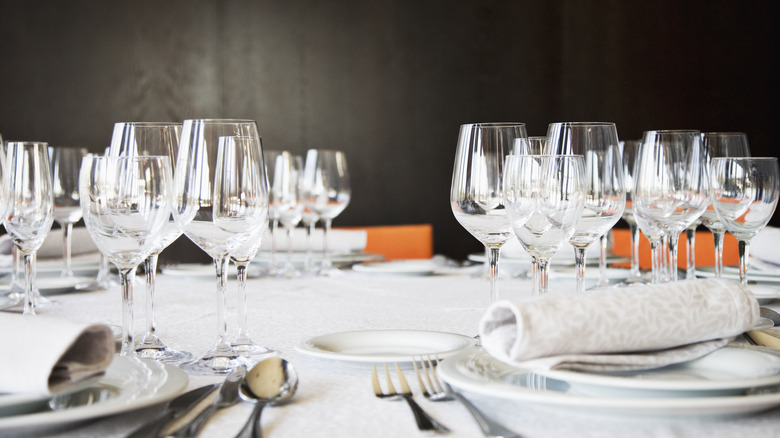You May Not Want To Store Delicate Stemware Upside Down
We may receive a commission on purchases made from links.
Wine appreciation can seem like a complex and expensive hobby. There are so many countries and winemaking regions to know, so many different grapes and styles, techniques and food pairings. At the same time, wine appreciation is more approachable than ever. Sure, you can spend hundreds of dollars on a vintage Bordeaux, but there are thousands of just-as-worthy wines that cost less than $25 and are complex and nuanced, with some of the best bargains coming from emerging regions like Greece, Scandinavia, Bolivia, Israel, Canada and even parts of the eastern South in the United States like Virginia's Loudoun County (per Vino Vest). And, despite all the complexities of appreciating wine, any good sommelier will tell you that you should drink what you like and what makes you happy.
If you're going to spend a few dollars on a decent bottle of wine, however, it's best to serve it in the proper glassware. Just like all other things relating to wine, you can totally geek out and argue the merits of every shape and size of each glass — and there are hundreds of styles — but, if you'd rather leave all that debate to the pros, you can stick to a few basic shapes: white, red, and flutes. From there you can fill out your collection with oversized models and delicate dessert wine glasses, depending on where your tastes lie.
Stemware basics
It doesn't take a lot to set a basic table: just some proper silverware; a dinner plate; a napkin; a water glass; and, of course, a wine glass. Decent stemware is more affordable than ever these days; and — whether you're a wine aficionado or a champion of Two-Buck Chuck — if you drink wine, chances are you've got something of a collection of wine glasses at home. If not, you can get basic sets for around $50 (per Food & Wine) that include both red and white glasses so that you can always have something for proper pouring.
Stemware is designed not just to look cool, but also to keep your hands away from the wine in the bowl of the glass. This is for two reasons. First of all, your body heat can warm the wine if you hold your glass by the bowl. Second, you'll also leave fingerprints if you hold your glass this way, which is not only a bad look, it's also bad table manners; so always hold your glass by the actual stem instead of the bowl. If you prefer using stemless wine glasses, you have no choice but to touch the bowl, so hold it towards the bottom of the glass with only your thumb, index, and middle finger (per Vino Vest).
Stemware care
Stemware is notoriously fragile, unfortunately, so once you've chosen your perfect pieces make sure you know how to take care of them properly. For starters, while you can wash them in the dishwasher, make sure you load your dishwasher correctly and don't use too much detergent, which can etch the glass or crystal over time (per The New York Times). If you're using one or two glasses in a night, just wash them by hand and don't leave them in the sink.
Next, make sure you're storing your glassware properly. Lots of people like to store their wine glasses the same way they do drinking glasses and mugs — upside down to prevent dirt and dust from collecting inside. While this is a good instinct, the most fragile, narrow part of a wine glass is the rim. The balance of the vessel is also inverted if you store them this way, so it's easier for your glasses to tip over and break, often crashing into the others and taking them all out at the same time. It's better to store them right side up in a closed cabinet to prevent anything from getting inside the glass (per Food Network). If you have open shelves, try placing a sheet of paper over the top of your glasses to prevent dust from getting inside. Or, if you really want to store your glasses upside down, invest in an under-counter rack.


